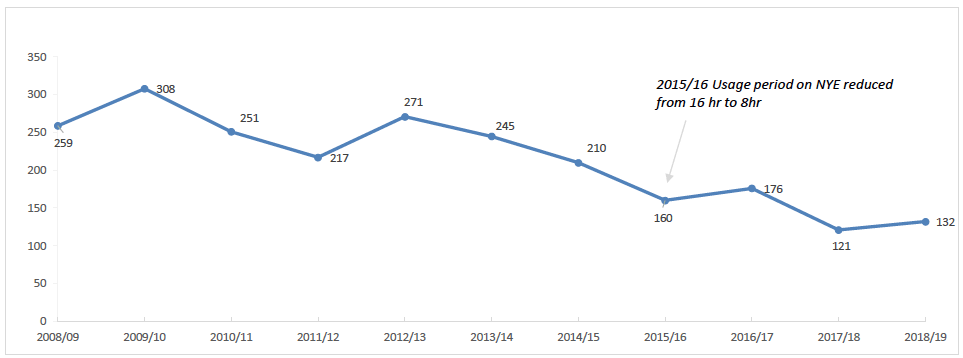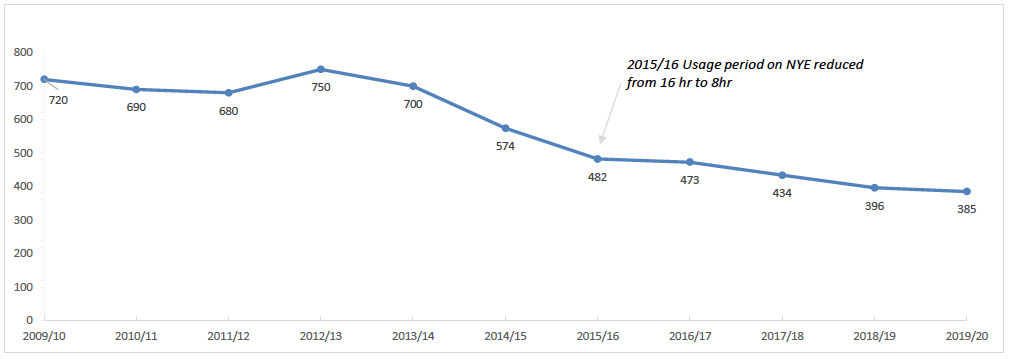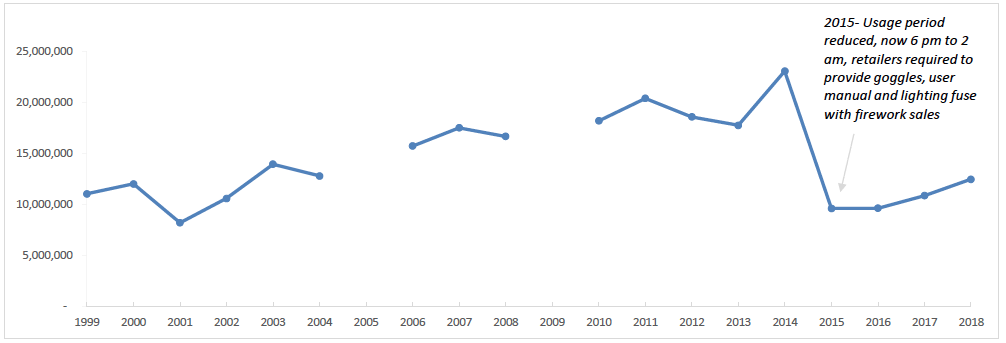Fireworks regulations - impact: case studies
This paper consists of seven case studies, each one aligned to one or more of the legislative options being considered by the Firework Review Group.
Netherlands
Main points
- The number of people sustaining fireworks-related injuries (all and eye injuries) around New Year's Eve has been consistently lower following the introduction of regulations in 2015 which reduced the usage period on 31 December from 16 hours to 8 hours, with the decline most pronounced amongst bystanders. During this time there were a number of firework safety campaigns, which may have also contributed.
- Data suggests that the 2015 reduction in the time fireworks can be used may have contributed to a decline in the number of firework incidents recorded by the police.
- The number of police recorded firework crimes was on an increasing trend from 2014 to 2018. Until 2018, the majority of such crimes were recorded in December of each year.
- Evidence shared by the Dutch Police notes that the number of incidents occurring in the vicinity of firework retailers, is 3-5 times higher during the permitted fireworks sales period compared to when they are not for sale.
- The Dutch Police seized increasing amounts of illegal fireworks in 2018 and 2019, but the lack of time series data means it is not possible to associate this with any regulatory changes.
- Anecdotal evidence from the Dutch Police suggests that the introduction of firework free zones resulted in a shift in hot spots for firework use.
- The volume of firework imports significantly declined in 2015 and was a similar level in 2016, pointing to a possible association with the reduced usage pubic usage period introduced in 2015.
- Due to the infancy of 2019 regulations requiring retailers to provide safety goggles, a user manual and lighting fuse to those buying fireworks, there is not yet any evidence regarding their effectiveness.
Current fireworks regulations [45],[46]
- Consumer fireworks (F2) can be purchased by the public (16 years and over) from licensed retailers on 29-31 December. If one of these days falls on a Sunday, no fireworks may be sold on that day. In that case, fireworks can be bought on 28 December.
- Consumer fireworks can only be used between 6 pm on 31 December and 2 am on 01 January
- Consumer fireworks sales cannot exceed 25 kilos per transaction/delivery
- As of 2019, it became mandatory for retailers to provide safety goggles, ignition fuses and user manuals to those buying fireworks
- As of 2020 the sale of F3 fireworks including bangers, firecrackers and rockets to the public is banned
- Many municipalities have restrictions in place around the use of consumer fireworks. In general, fireworks are prohibited near shopping centres, nursing homes, animal shelters and historic buildings and monuments.
- In 2020 Amsterdam and Rotterdam city councils approved plans for a complete ban on consumer fireworks in their respective areas[47]
- Aligned legislative options: D, F, H, I, J
Policy background
Fireworks in the Netherlands are mostly regulated through the Fireworks Decree (Vuurwerkbesluit), enacted in 1993 but amended numerous times since, including in the wake of the 2000 Enschede disaster where 23 people died and almost 1,000 were injured following an explosion at a fireworks depot. In 2014 the decree was amended to reduce the period in which consumer fireworks could be used. Previously people could set off fireworks from 10 am on 31 December to 02 am on 01 January, but this was changed to 6 pm on 31 December, halving the permitted usage period. This change was effective from 2015.[48]
In October 2019 it became compulsory for Dutch retailers to provide safety goggles, ignition fuses and user manuals to those purchasing fireworks[49]. This followed the success of national safety campaigns and prior to it being mandatory, many firework retailers made safety goggles available to customers free of charge.
On the 31 January 2020, the Dutch Cabinet agreed to end the sale of bangers, firecrackers and rockets to the public from the 2020 New Year's sales period. The decision was in line with police and safety board recommendations, with the latter calling for the ban since 2017[50]. Reducing the risk of injuries to the public and the dangers posed to the emergency services were the main policy drivers. Earlier this year, the city councils of Amsterdam and Rotterdam approved a total ban on consumer fireworks, effective from the 2020 fireworks sale period. Injuries, inconvenience to local residents and an 'atmosphere of lawlessness' were the primary motivations[51]. The number of injuries, police incidents and concerns around illegal fireworks means fireworks regulations are frequently debated and scrutinised in the Netherlands.
Impact of regulations: eye injuries
From 2008 to 2019 a yearly survey of fireworks-related eye injuries seen and treated by ophthalmologists around New Year's Eve[52], was recorded in the Netherlands[53]. Graph 6 shows that the number of persons sustaining eye injuries declined markedly in 2015/16, coinciding with the introduction of the reduced usage period. Since then there has been no definitive trend but the numbers have remained below pre 2015/16 levels, suggesting that the measure have had some impact. The study notes that during this time, there were a number of firework safety campaigns and although not a legal requirement until 2019, many retailers provided customers with safety goggles for free. Therefore it is possible that these factors also contributed to this decline.

Source: 'National studies from the Netherlands and Finland and the impact of regulations on incidences of fireworks-related eye injuries', 2020
In addition to the total number of persons with eye injuries, Table 6 shows whether the person was injured through using a firework (self-inflicted) or as a bystander. In 2015/16, there was a sizeable drop in the number of bystanders injured, from 112 in 2014/15 to 65. Although the figures have varied in recent years, the number of persons with self-inflicted fireworks injuries and the number injured as bystanders have been consistently lower since the introduction of regulations in 2015/16.
As we can see, from 2008/09 to 2011/12 the split between self-inflicted and bystanders was fairly even. Since 2015/16, the majority of those presenting with eye injuries have been firework users, perhaps indicating that the regulations and safety campaigns have been most effective amongst bystanders. The study also found that across the 11 years, three types of fireworks have caused 71% of eye injuries, not all of which are legal: firecrackers (35%), bottle rockets (25%) and roman candles (11%).
| 2008/09 | 2009/10 | 2010/11 | 2011/12 | 2012/13 | 2013/14 | 2014/15 | 2015/16 | 2016/17 | 2017/18 | 2018/19 | |
|---|---|---|---|---|---|---|---|---|---|---|---|
| Persons with eye injuries | 259 | 308 | 251 | 217 | 271 | 245 | 210 | 160 | 176 | 120 | 132 |
| Self-inflicted | 109 | 148 | 126 | 108 | 158 | 147 | 98 | 95 | 95 | 72 | 76 |
| Bystanders | 150 (58%) | 160 (52%) | 125 (50%) | 109 (50%) | 113 (42%) | 98 (40%) | 112 (53%) | 65 (41%) | 81 (46%) | 48 (40%) | 56 (42%) |
Source: 'National studies from the Netherlands and Finland and the impact of regulations on incidences of fireworks-related eye injuries', 2020
Impact of regulations: injuries
VeiligheidNL (Safety Netherlands) monitors all accidents in the Netherlands through the Dutch Injury Surveillance System (linked to emergency department data) together with other sources. Each year they report on the number of people treated for firework injuries at emergency departments on 31 December and 01 January. Figures from 2009/10 to 2019/20 are shown in Graph 7.
The number of people attending emergency departments with firework injuries during the New Year celebrations has been on a downwards trend since 2013/14. Consequently, 335 fewer people were seen at emergency departments in 2019/20 than in 2009/10, a 46% decrease. In 2019/20 hospitals recorded additional information on 245 patients with fireworks injuries, of which around a fifth (19%) had sustained injuries caused by illegal fireworks and half (51%) were bystanders[54].
The graph shows that 50 fewer people were injured in 2015/16 than the previous year, coinciding with the enactment of the reduced usage period and ongoing safety campaigns. The number of people presenting at emergency departments with fireworks injuries has been consistently lower since the introduction of the 2015 regulations concerning times of use.

Source: VeiligheidNL
Impact of regulations: crime
The Dutch Police publish information on the number of recorded police incidents[55] occurring from midnight on 31 December to 8 am on 01 January. The number of firework incidents for 2014/15 to 2019/20 is shown in Table 7. There was a sizeable decline in the number of firework incidents in the three years up to and including 2017/18, coinciding with the introduction of greater restrictions on when consumer fireworks could be used. The number has increased over the previous two New Year periods, although it is too early to say whether this amounts to an increasing trend. Irrespective of this recent rise, there was 33% fewer firework incidents during the 2019/20 New Year compared to 2014/15.
| 2014/15 | 2015/16 | 2016/17 | 2017/18 | 2018/19 | 2019/20 | |
|---|---|---|---|---|---|---|
| Number of firework incidents | 5,068 | 4,131 | 3,573 | 2,687 | 3,129 | 3,375 |
Source: Dutch Police
Evidence shared by the Dutch Police notes that the number of incidents occurring in the vicinity of firework retailers is 3-5 times higher during the permitted fireworks sales period compared to when they are not for sale[56]. During the course of New Year's Eve 2018/19, 10% of all fireworks-related nuisance occurred within a 250 meter radius of firework outlets. In addition, analysis shows that in areas where there is a lot of fireworks nuisance, the number of incidents and reports peaks twice on New Year's Eve: 1) between 1 pm and 3 pm, 2) between midnight and 2 am on 01 January. Elsewhere the number of incidents and reports generally increases as the day progresses.
In response to a request for information, the Dutch Police provided data on recorded firework crimes^ and the numbers from 2012 to 2019 are included in Table 8. The data suggests that from 2014 to 2018 illegal firework activities were an increasing problem, as the total number of such crimes tended to increase each year, although part of this could be a reflection of policing activities and public reporting (see 'notes on evidence' section). It would appear that reducing the time in which fireworks could be set off for New Year 2015/16 did not have a noticeable impact on the number of recorded offences. Further data points are needed before it can be determined whether the sizeable decline in 2019 (31% decrease on 2018) is the start of a downwards trend.
The table also shows that until 2018, the majority of offences were recorded in December of each year. Again, further data is needed before it can be established if the shift (majority recorded out-with December) in 2018 and 2019 amounts to a trend. Although requested, it was not possible to disaggregate the data into specific firework offences.
|
|
2012 | 2013 | 2014 | 2015 | 2016 | 2017 | 2018 | 2019 |
|---|---|---|---|---|---|---|---|---|
| Total | 587 | 513 | 563 | 607 | 606 | 820 | 1,065 | 730 |
| December | 338 58% | 326 64% | 351 62% | 366 60% | 341 56% | 616 75% | 447 42% | 341 47% |
Source: Dutch Police
*Recorded by police in official report.
^Includes crimes of ‘illegal import or export as well as transportation of
fireworks’ and ‘illegal possession, manufacture or delivery of fireworks.’
The Dutch Police also shared data concerning the volume of illegal fireworks they have confiscated in the past three years. As we can see from Table 9, the volume seized rose in 2018 and 2019. Earlier time series data is needed in order to assess the impact of legislative measures and to determine if any trend is apparent. The police noted that the majority of confiscated fireworks were F4 class fireworks (professional).
| 2017 | 2018 | 2019 | |
|---|---|---|---|
| Volume of illegal fireworks seized (KGs) | 40,382 | 56,525 | 61,429 |
Source: Dutch Police
In the Dutch justice system approximately a third of minors (aged 12-17) who are arrested are referred to 'Halt punishment', a diversional measure where they undertake an alternative sanction, avoiding prosecution and a criminal record. Referrals for firework offences typically make up about 10% of the total Halt referrals each year. Table 10 outlines the number of firework referrals from 2015/16 to 2019/20. There is not yet enough data points to determine whether there is an increasing trend in the number of referrals for firework offences, but there was a sizeable increase in 2018/19 accompanied by a smaller rise in 2019/20. Consequently, there were 332 more referrals in 2019/20 than in 2015/16.
| 2015/16 | 2016/17 | 2017/18 | 2018/19 | 2019/20 | |
|---|---|---|---|---|---|
| References to Halt Punishment | 989 | 999 | 950 | 1,279 | 1,321 |
Source: Data request to Halt
*Aged 12-17 years.
Impact of regulations: firework free zones
The Dutch Police provided anecdotal information regarding firework free zones. As noted earlier, many cities and municipalities have measures in place restricting the use of fireworks, including firework free zones. A study was carried out in 2019 to identify the effects of firework free zones. On the main conclusions was that the introduction of the zones had resulted in a shift in hot spots for firework use. For example in the city of Alkmaar the public experienced more negative effects just outside the firework free zones. The police were unable to share a copy of the study.
Impact of regulations: imports
The World Bank publishes figures on fireworks imports[57] via the World Integrated Trade Solution database. The volume (Kg) of Dutch gross fireworks imports from 1999 to 2018 is presented in Graph 8. It is important to note that this incorporates all firework imports, not just those for public sale/use. As we can see there was a significant decrease (approx. 13,500,000 Kg) in the volume of firework imports in 2015 and the figure was broadly similar in 2016. This coincides with the introduction of the reduced usage period for New Year's Eve 2015. Figures increased slightly in 2017 and 2018 but further data is required to see if this amounts to an increasing trend.

Source: World Integrated Trade Solution * Harmonised system code 360410.
^ No data available for 2005 and 2010.
Contact
Email: socialresearch@gov.scot
There is a problem
Thanks for your feedback